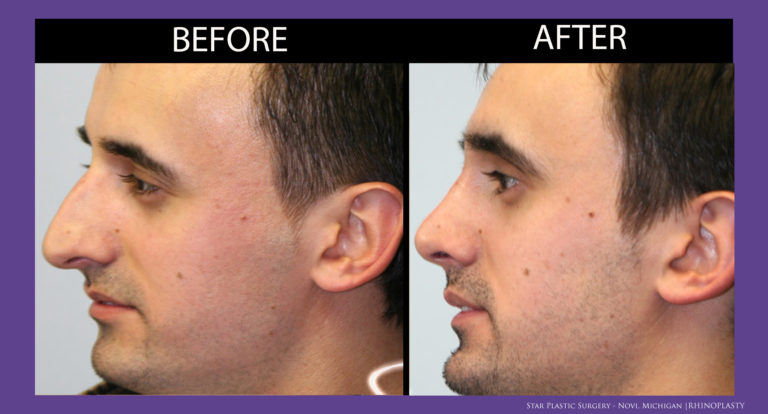What To Expect – Bruising After Rhinoplasty
Having any kind of surgery is a serious commitment. An honest and ethical surgeon will always provide full disclosure about what to expect after a procedure.
While bruising is common after many procedures, the bruising after rhinoplasty can be particularly remarkable. Especially in cases where the procedure is more extensive.
Understanding that bruising is the body’s natural response to the healing process and that it will go away after two or three weeks can bring comfort. Even so, a face that appears battered around the nose and eyes can be shocking to a patient who hasn’t been prepped for it.
Rhinoplasty Is SO Worth It Though
Many patients consider rhinoplasty because they’re currently not happy with the appearance of their face. With the nose being a major focal point on the face, some alterations through rhinoplasty can do wonders to improve one’s facial appearance.
As such, patients are often excited to see the results after the procedure and can feel let down by the appearance of bruising. For those who only needed a simple change to the nasal tip, the bruising may not be too extreme.
For those who need changes that involve breaking and resetting the bone, manipulating nasal cartilage, and/or altering the framework of the nose, however, the bruising can be more extensive.
Whatever the case, with proper care and attention the bruising does eventually subside and the patient is left with the increased confidence that comes with a brand new appearance.
The 411 on Bruising After Rhinoplasty
As always, the best way to help prevent major bruising is take preemptive measures to stay healthy (quit smoking, drink plenty of water, eat a nutritious diet, etc.) before the surgery. In addition, always follow the surgeon’s instructions to a tee. A patient must also disclose any blood thinners, other medications, or even supplements he or she is taking as they may need to avoid them to promote healing.
Again, the extensiveness of the procedure as well as the individual’s own ability to heal will all be factors in how long to expect bruising. We’ll look at a general timeline here though.
The First Few Days
Bruising can appear immediately following rhinoplasty surgery. These early bruises tend to be more red in color because of oxygen in the blood. Thus, they may not look as severe.
It’s in the days that follow this that the bruising becomes more apparent. At this point, they become darker purple, blue, or even black. This is normal for a few days.
Five to Ten Days Later
As the body continues to heal over those first five days, the bruising starts to change colors. It will fade from intense purple to a lighter purple with shades of green. By the time the patient hits day ten, the blue and purple may be completely gone and the colors shift from green to yellowish-brown.
Two to Three Weeks After
Most patients with who have had extensive work will find their bruising completely gone after three weeks. For those who had a simpler procedure, it could be as little as two weeks.
When you look at the big picture and in the scope of one’s life, it’s not really that long. Right?
Reap the Benefits of Rhinoplasty
Despite the strong possibility of facial bruising after rhinoplasty, the benefits of having one far outweigh this temporary inconvenience.
So if you’re ready to discuss the possibility of rhinoplasty with an experienced and board-certified plastic surgeon, contact us today.
And prepare to love your new face.
Rhinoplasty 092022
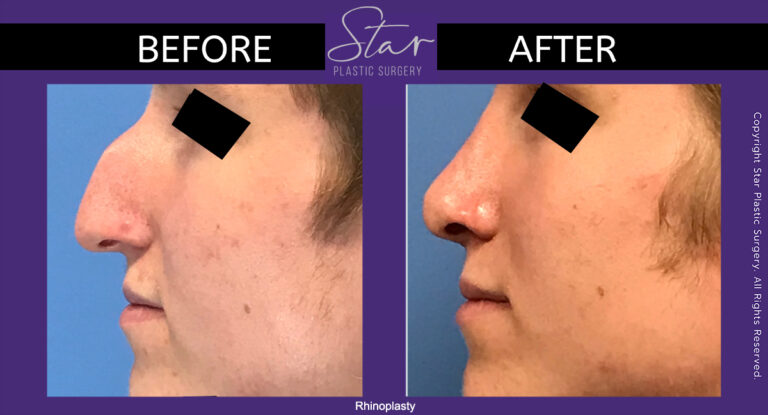
The Difference Between Closed and Open Rhinoplasty
If you’re shopping around for a nose job – more elegantly known as a rhinoplasty – you may not be aware that there are closed and open rhinoplasty procedures.
And you may not even care. That’s okay. We get it. For example, if you have a deviated septum, you may just want to breathe normally and not care how it happens.
But in case you ARE interested – and are wondering which one is right for you – we’ll lay out the differences between the two here.
How Closed and Open Rhinoplasty Differ
Whether you’re getting closed or open rhinoplasty, the surgeon will lift the skin of the nose, alter the bone and cartilage, then lay the skin back down. That’s the basics of rhinoplasty 101. Of course, it’s much more complicated than that. And the ways the surgeon customizes each rhinoplasty is its own art form.
The only thing you really need to know is that with a rhinoplasty, there are just two ways for the surgeon to access the structure of the nose. There is the closed version and the open version.
With closed rhinoplasty, the surgeon makes two incisions inside the nose and makes the alterations through these incisions.
An open rhinoplasty utilizes the same two incisions. But then there’s a third incision that connects them. It goes across the columella (the skin between the two nostrils) and is known as a trans-columellar incision. It is this third incision that opens up and unveils what’s happening in the nose.
Which procedure is utilized will depend on what the surgeon is attempting.
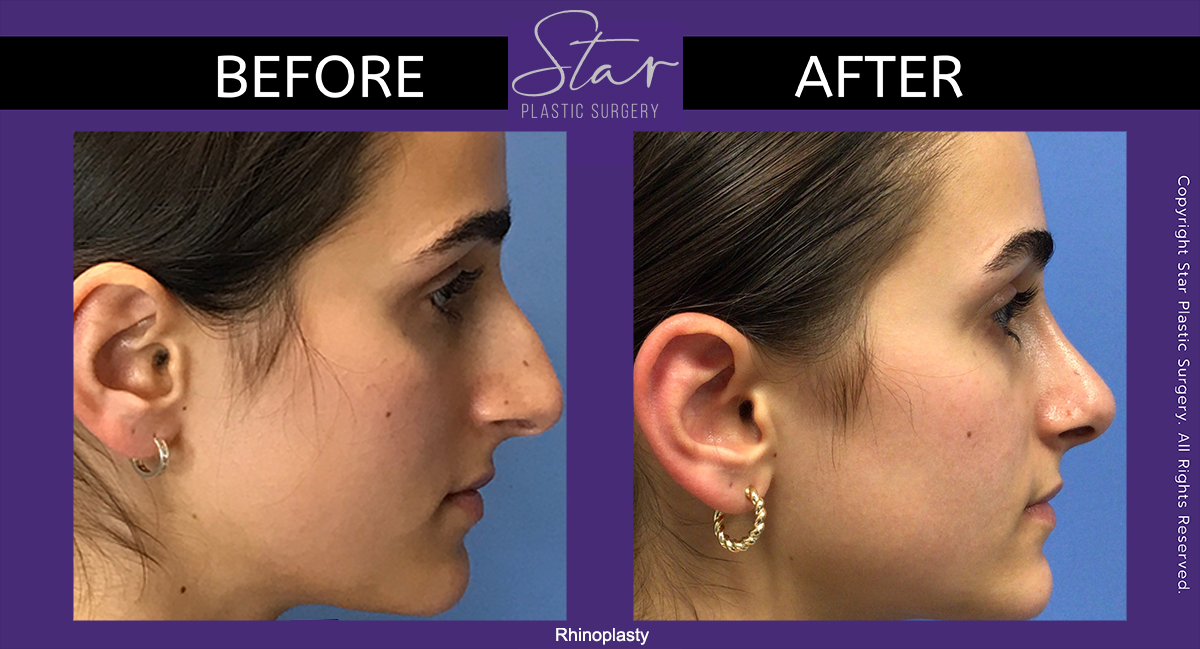
When a Closed Rhinoplasty Is Preferred
Of the two approaches, the closed rhinoplasty is less complicated. And because the incisions are made inside the nose, there is no chance of a visible scar.
Plus, because a closed rhinoplasty is not as intensive, there tends to be less swelling during recovery. But less intensive also means that it may not be an option for those seeking a more complicated fix.
As such, the closed rhinoplasty is typically restricted to patients who need minimal work on their noses with reasonable symmetry. Sculpting of the dorsum and narrowing of the tip and bones may be performed in a closed rhinoplasty. Even so, it’s a viable option in those situations where the plastic surgeon deems it so.
Choosing an Open Rhinoplasty
During an open rhinoplasty, the surgeon is able to see the anatomy underneath. This is a plus in that it allows the surgeon to measure and more deeply analyze the anatomy of the nose to see any asymmetries or abnormalities. With a clear understanding of the anatomy of the patient’s nose, he or she can perform more detailed work.
In a nutshell, an open rhinoplasty allows for more correction of asymmetries and is ideal for noses that require cartilage grafting to add more structure to an otherwise amorphic nose. Since the nose is such a prominent feature on the face – as well as one of the more delicate anatomical structures of the body – precision is a desirable attribute (to say the least!).
In addition, for cases that require advanced cartilage grafting techniques, an open rhinoplasty enables the surgeon to more accurately place those grafts. And although an open rhinoplasty requires a visible incision, with advancements in surgical procedures, scarring is extremely minimal to non-existent.
For these many reasons, the open rhinoplasty is often the preferred method.
Which Rhinoplasty Is Your Best Bet?
If you’re ready to explore your rhinoplasty options, contact us today.
We’ll sit down with you during your free consultation and discuss the benefits of closed and open rhinoplasty procedures for your specific situation.
Rest assured, you’ll get the one that’s right for you.
Rhinoplasty 7-22
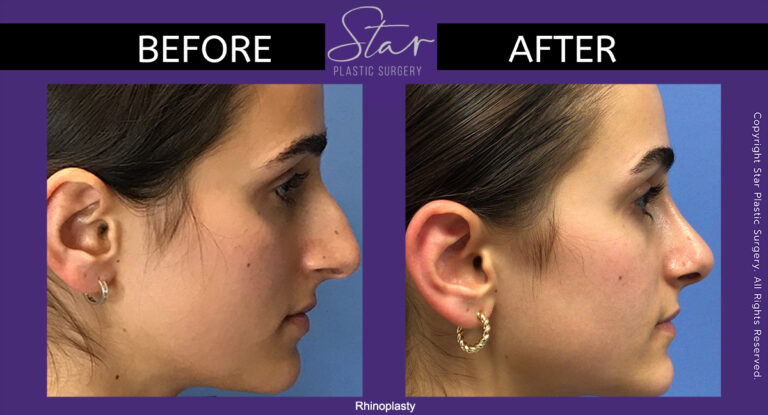
Recovering From Rhinoplasty
Ask the vast majority of patients who’ve had a rhinoplasty from a highly qualified surgeon, and they’ll tell you that it’s life-changing.
Even if you desire only a minor change, it can have huge impact on your appearance and confidence. It could even help you sleep better!
But it’s important to remember that it is a surgical procedure. So knowing what to expect when recovering from rhinoplasty can lead to a more satisfying outcome.
Upon Leaving the Procedure
First things first.
Rhinoplasty is a complicated surgery. There isn’t a standard order of steps that board-certified surgeons follow. Instead, they must tailor each operation for the patient. Even so, the vast majority of rhinoplasty procedures are out-patient and the patient can leave the hospital the same day.
It’s the first week after the procedure that’s the most intense. In most cases, the surgical site will be splinted or packed on the inside. The nose itself will be covered with bandages to protect it and allow for healing as it adapts to its new shape. This dressing needs to say in place for one week. Because of this, patients should plan to take that week off from work, school, or other obligations.
Pain and swelling during this time will be most pronounced – with some bruising and tenderness under the eyes and on the cheeks. You’ll need to follow your surgeon’s detailed post-operative instructions during this time. Proper post-op care will contribute to the surgery’s success.
The Down-Low On Recovering From Rhinoplasty Long-Term
Once the bandages come off, one of the first things patients want to know is how long before they’ll see results. Typically, initial results appear within the first few weeks to a month as the tissues begin to heal. This doesn’t necessarily mean that you’ll have the final nose shape you desire at that point though.
For some patients, the swelling can take a considerable amount of time to subside. So even though you’ll see a marked difference within weeks, it could potentially take several months or up to year to achieve that final nose shape.
This is because the soft tissues of the nose are more prone to holding swelling than other parts of the body. But rest assured, the swelling does eventually subside.
And the initial swelling immediately post-op usually goes down enough so that patients are able to return to work and light activity in about two weeks. This will, or course, vary from patient to patient depending on how strenuous their job. But that’s a safe ballpark figure.
Ready To Talk With a Board-Certified Plastic Surgeon?
Although recovering from rhinoplasty may sound challenging, it’s truly one of the most beneficial procedures.
So whether your reasons for seeking rhinoplasty are cosmetic or structural, contact us today to talk with one of our board-certified plastic surgeons.
He or she will be able to discuss with you in detail this amazing procedure and what you can reasonably expect as you head out to ‘face’ the world again!
Open Rhinoplasty
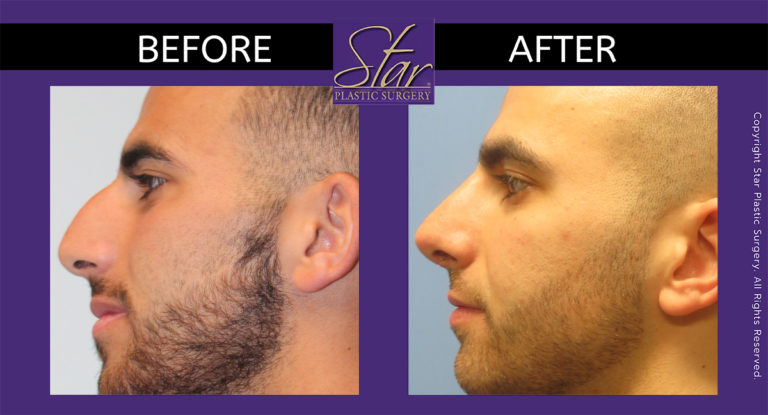
Open Rhinoplasty
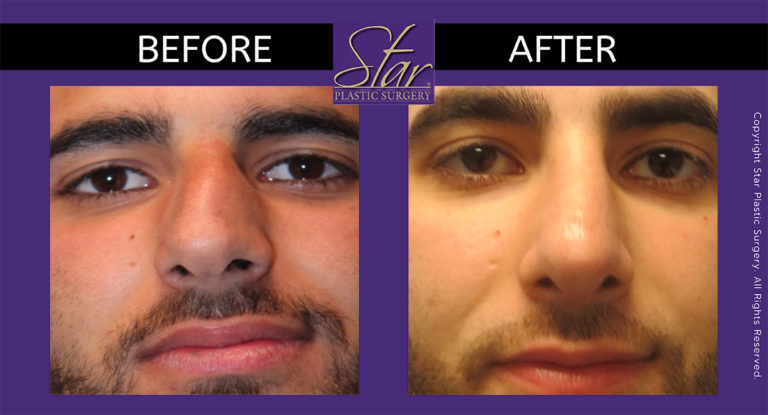
Rhinoplasty
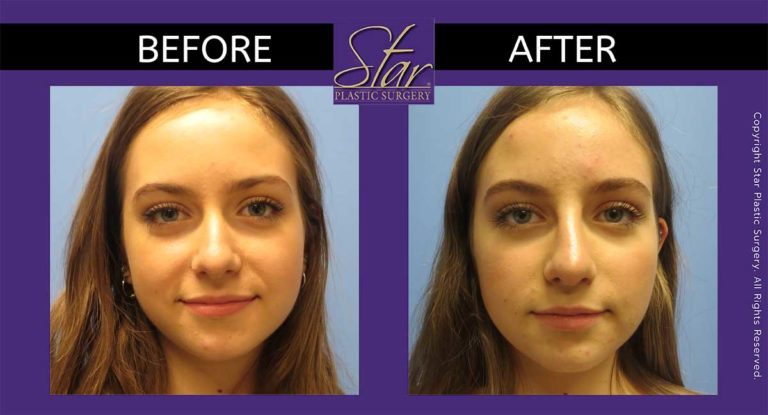
The Benefits of Rhinoplasty or Septoplasty
There’s a good chance you’ve heard the term “nose job.” And you may already know that rhinoplasty is the medical term for a nose job.
A nose job might include removal of the nasal hump, reshaping of the nasal tip, reshaping or resizing of the nostrils, or increasing or decreasing the nose’s overall size, projection, and rotation.
But you may not know about septoplasty. This is also a term for the correction of a deviated septum. The septal cartilage may also be used for grafting during the cosmetic portion of a rhinoplasty.
While each procedure is different, both result in a better-looking and/or more functional nose for increased confidence.
So we’ll take a look at the benefits of rhinoplasty or septoplasty, or both.
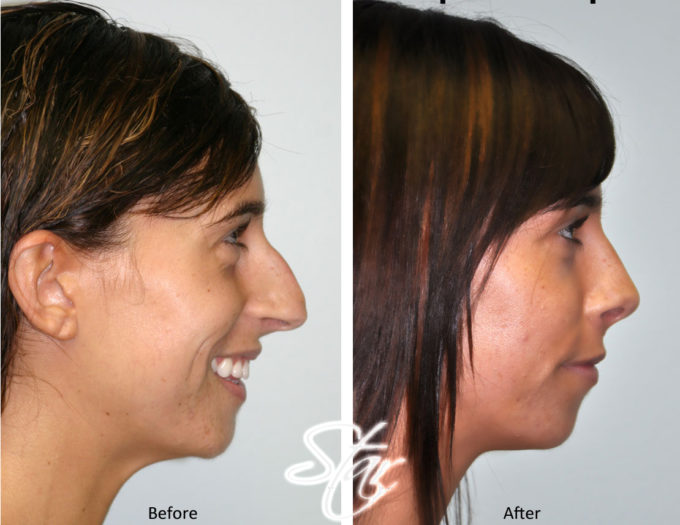
The Nitty Gritty on Rhinoplasty
Rhinoplasty is considered one of the most common cosmetic procedures in the world. But it’s still important that it be performed by a board-certified plastic surgeon who is experienced in the rhinoplasty.
The nose is a complex structure made of delicate cartilage, bone, mucosal lining, and skin. Even a small change to one part of the structure will impact the rest of the nose. Thus, if there’s to be a natural and functional outcome, rhinoplasty requires expertise.
Rhinoplasty is an outpatient procedure that generally takes 1.5 to 3 hours to complete. There are both closed and open rhinoplasty.
In closed rhinoplasty, incisions are made within the nostrils. By contrast, in open rhinoplasty, an incision is made across the tissue between the nostrils as well as within the nostrils.
These incisions heal well and are barely visible once healing is complete.
Recovery after Rhinoplasty
Most patients experience mild to moderate discomfort after surgery. This can typically be controlled with medication.
There will also be some possible bruising under the eyes. And patients should expect to wear a splint outside of the nose for about a week. This can make it awkward to be in social settings.
But the splints are necessary to protect the nasal bones and cartilage, as well as to limit the swelling of the skin.
After the procedure, patients will need to avoid strenuous activity for two weeks, contact sports for 4-6 weeks, and wearing glasses for 4-5 weeks.
What Is Septoplasty?
The bone and cartilage that divides the space between your two nostrils is known as the septum.
A deviated septum is the term for a crooked septum. Someone with a deviated septum can have difficulty breathing through the nose and may be at a higher risk for sinus infections due to poor drainage.
Septoplasty is a surgical procedure that straightens that bone and cartilage. The septum is repositioned to the middle of the nose. Portions of the septum may be used to augment the nose or narrow the tip.
To do this, the surgeon may need to cut and remove parts of the nasal septum before reinserting them in the proper position. But once a septoplasty is healed, the patient usually finds that it’s easier to breathe.
Recovering from Septoplasty
Because septoplasty with a rhinoplasty is a bit more involved than rhinoplasty alone, patients may have a few more restrictions. This will depend on the extent of your surgery. Occasionally, a splint is placed inside the nose after septoplasty.
To decrease the chances of bleeding and swelling, you need to elevate your head when you’re sleeping, wear clothes that don’t need to be pulled on over your head, avoid strenuous activities for up to four weeks, and don’t blow your nose for several weeks.
It’s a small price to pay though for being able to breathe more fully and easily. And within 2-3 months after surgery, the nasal tissues are relatively stable. While most of the swelling is gone in the first month, 100% of swelling resolution can take up to one year.
Could the Benefits of Rhinoplasty or Septoplasmy Serve You?
Whether you’re unhappy with the appearance of your nose, or you’re having trouble breathing, you will likely reap the benefits of rhinoplasty or septoplasty.
So contact us today to learn all about your options.
Your surgeon will consider a customized plan to modify your nose in a way so that it appropriately suits your face and allows you to breathe more freely.
It could be life-changing for you.
Rhinoplasty-006
